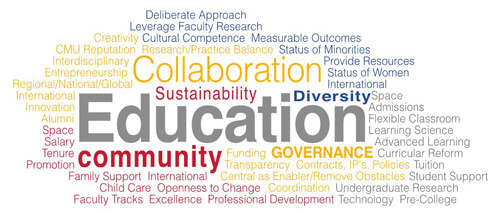Voices Heard
Planning Process a “Remarkable Effort in Transparency”
By Bruce Gerson / bgerson@cmu.edu
The university’s new strategic plan has the CMU community’s fingerprints all over it.
Strategic Plan 2025 was developed in large part from issues, concerns and objectives discussed at length in the many working group sessions that focused on the CMU experience.
Professors Todd Przybycien, Scott Sandage, Joel Greenhouse, Kristen Kurland and Ronald Placone led the Faculty Working Group that organized and conducted focus groups in all seven colleges and one for University Professors.
“We asked faculty what was on their mind. We realized problems and concerns would be the first things that came to mind, but we felt by information gathering we could reverse engineer the information and feed it back up into an overall goal. We felt problems, issues and concerns would be emblematic of some larger goals we could tackle,” said Przybycien, a professor of chemical and biochemical engineering and chair of Faculty Senate.
 Bubbling to the top were topics that centered around six themes — education, collaboration, governance, community, diversity and sustainability.
Bubbling to the top were topics that centered around six themes — education, collaboration, governance, community, diversity and sustainability.
Focus group sessions included six to 12 faculty members, representing various faculty ranks and tracks in addition to gender and race. In all, 69 faculty members participated.
Many hours and more than 60 pages of meeting notes were digested and synthesized with the help and expertise of Elizabeth Monaco, manager of the Organizational Effectiveness Group at the SEI, and Beth Whiteman, director of Accreditation and Strategic Initiatives.
The result is a report titled “Faculty Voices,” which includes six goals and 34 recommended tactics. The report was distributed to all faculty.
Przybycien said there are similarities and “nice reflections” between the “Faculty Voices” and the overall strategic plan.
“There’s a lot of overlap. It says that what the faculty are thinking is in resonance with what other groups across campus are thinking. It’s encouraging that we’re all pulling in the same direction,” he said.
Sandage, an associate professor of history and immediate past chair of Faculty Senate, agrees.
“We were really gratified to see that just about everything on our list had made it into the overall planning document. This is as much a tribute to the overall process and campus-wide conversations having generated and identified the same ideas, as it is a result of the faculty being clearly heard.
“Either way, the year-long inclusive process was a remarkable exercise in transparency and building consensus,” Sandage said.
“Faculty Voices” also provides a blueprint for Faculty Senate.
“Todd [Przybycien] very clearly saw the opportunity for the focus group report to invigorate the work of the Faculty Senate, by becoming a living document that provides several years’ worth of important agenda items for the Senate to work on and pursue,” Sandage said.
Przybycien identified “low-hanging fruit,” including making the faculty evaluation process and promotion criteria more transparent and consistent across campus. Another was seeking to balance the technical and creative aspects of the university in its marketing and branding efforts.
Like the Faculty Working Group, staff also played an integral role in the strategic planning process.
A nine-member Staff Working Group, co-chaired by Denise Fazio and Matt D’Emilio, gathered input from staff through a town hall meeting hosted by Staff Council, and through a grassroots effort that sought feedback from divisions and departments via Staff Council reps.
The Staff Working Group identified three themes — The Staff Experience, Civility/Civil Discourse, and Transparency and Innovation Infrastructure.
Staff expressed interest in enhancing diversity, personal and professional growth, staff status, and compensation and advancement. They also suggested that supervisors attend management and sensitivity training.
Transparency in governance and improved campus-wide policies for areas such as parental leave, child care, senior care, parking and a healthy campus also were presented to strategic plan leaders.
“All aspects of the Staff Working Group plan made the cut,” said D’Emilio, director of the University Contracts Office and this year’s chair of Staff Council. “I can say with certainty that issues raised by staff are addressed in the Strategic Plan 2025.”
D’Emilio said the next step is implementation and assessment.
“Denise [Fazio] and I both believe that the key is to maintain the momentum of the plan. Now is the time for all staff to look at the plan and forward ideas on how to achieve the goals,” he said.
Students also informed the strategic plan.
Onur Albayrak, a Ph.D. candidate in the Physics Department, attended several meetings with Carolyn Commer, a Ph.D. student in English and president of the Graduate Student Assembly.
Albayrak said highlights of discussions focused on apprenticeship and mentorship, and innovative and interdisciplinary encounters for students.
“This whole process where we would meet and brainstorm about issues was very enlightening,” Albayrak said. “I think at the end we were quite happy with the result as how we can form a strategic plan where we can guide the way for future students and everyone that is part of CMU.”
Pictured above is a world cloud representing prominent topics that were dicussed in fauclty focus groups. The discussions centered around six themes — education, collaboration, governance, community, diversity and sustainability.
